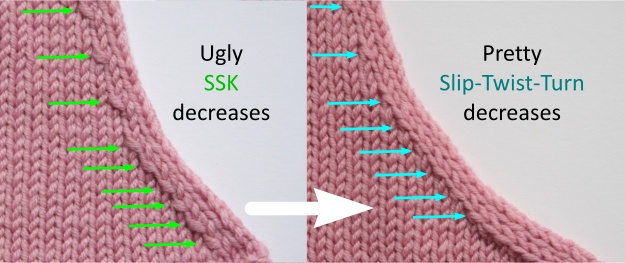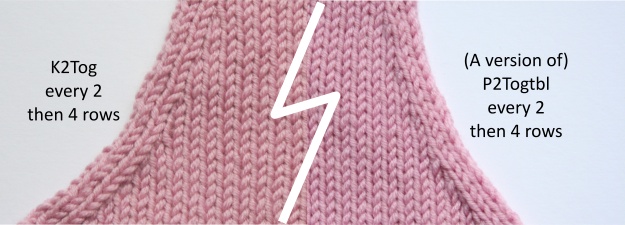The commonly used left-leaning decreases look ugly. Instead of the neat, orderly line formed from a series of right-leaning K2Tog† decreases, the left-leaning SSK decreases are large and loopy and don't line up with the stitches above and below them. But there are things you can do to tidy them up.

There are three problems to fix in order to tidy up a left-leaning decrease:
- Oversized stitch. When you work any stitch, extra yarn is pulled into it from surrounding stitches. Working the next stitch usually pulls that excess out again. When you work the stitch following a K2tog you pull the excess from the front stitch of the decrease, but with an SSK, working the following stitch pulls yarn from the back stitch. This leaves excess yarn in the front, visible, stitch of an SSK.
- Twisted stitches. Knitting through the back loops gives a twisted stitch.
- Decrease column not lining up. The left-leaning decrease is usually worked on the right/knit side, but you get a neater column of multiple decreases, closer to a mirror-image of the K2Tog, when it's worked on the wrong/purl side (see picture below).

Most approaches I've come across to neaten the left-leaning decrease work well if you're decreasing every other row. With sweater shaping the decrease rate is often less frequent though, and then the decrease stitches are either still evident, or the method leaves the stitches tight on the inbetween rows.
The P2Togtbl variation (I'm calling it P2Togtbl-Twist) mentioned in the picture above looks good, but has the rather major disadvantage of being impossible if you're working in the round. Even if you are knitting flat and so have purl rows, you would be required to amend your pattern and remember to do left-leaning decreases on the purl row instead of the knit row.
After much experimenting, along with guidance and inspiration from TechKnitter's SYTK, Cat Bordhi's Hungry Stitch and Rililie's LK2Tog, I've worked out a way to make a tidy decrease whatever the decrease rate. I'm calling it Slip-Twist-Turn.
Slip-Twist-Turn Tutorial

Work to the point in your knitting where you're going to decrease.

Slip the next stitch knit-wise.

Insert the right hand needle in the next stitch as if to slip purl-wise, but instead stretch the stitch towards you to remove the excess yarn from the first slipped stitch.

Now insert the right hand needle into the back leg of that same stitch and...

...transfer the twisted stitch to the right hand needle. The twist captures the excess yarn that would otherwise transfer to the slipped stitch and give a loopy decrease.

Turn the work so the wrong/purl side is facing you.

Now for a tricky backwards P2Togtbl. Take the right hand needle behind the work and push the tip through both stitches towards the tip of the left hand needle...

...with the right hand needle coming out underneath.

Then we have to form the stitch back to front. Lay the yarn over the underneath (right hand) needle and take that needle back out the way it came in...

...catching and scooping the yarn along with it...

...and leaving the new stitch created on the right hand needle.

Slip the new stitch back by taking the left hand needle through its back loop.

Turn the work back round so the right side is facing, and the decrease is done. Continue working along your row.

In this swatch the decrease is worked every 2 and then every 4 rows, and is always neat!
This will be just too much faff for some people, and it's not necessary for some situations - such as lace knitting and working with fuzzy or tweedy yarns. It will also require a bit of practice, but it does become much easier. And I've finally got a left-leaning decrease that I'm happy with!
So.. have you got a better way, that still looks tidy when decreasing less frequently than every other row? I'd love to hear it and any other thoughts! Send an email to hello@yarnsub.com or leave a comment on the YarnSub Facebook page.
Notes
The P2Togtbl-Twist uses a twisted slip stitch to remove extra yarn from the decrease stitch, just as in the Slip-Twist-Turn decrease above.
For this stitch, work to the point in the purl row where you're going to decrease:
- Twist the first stitch by putting the right hand needle behind the back/left leg of the stitch and then slip the stitch to the right hand needle from that position, so that back leg ends up in front.
- Slip the next stitch knitwise.
- Transfer both stitches back to the left hand needle in their new orientation.
- P2Togtbl
† Abbreviations
- K2Tog — Knit two together
- P2Togtbl — Purl two together through the back loops: a left-leaning decrease (when viewed from the front). Usually worked as: Slip 1 knitwise, slip 1 knitwise, transfer both stitches back to the left hand needle in their new orientation then purl these two stitches together through the back loop. For this take the right hand needle behind the two stitches on the left hand needle and then through the back loops with the tip of the the right hand needle heading towards the tip of the left hand needle. Then purl the stitches together as for a normal purl stitch.
- SSK — Slip, slip, knit: a left-leaning decrease. At the point on a knit row where you want to decrease, slip the first stitch knitwise, slip the second stitch knitwise. Insert the left hand needle into the front of these two stitches on the right hand needle, from left to right, then knit them together from this position, i.e. through the back loops.
